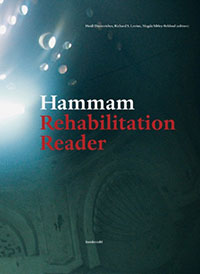

The HAMMAM project develops scenarios for the adaptive reuse of the hammam as a public service centre for Islamic Mediterranean cities. In an interdisciplinary negotiation process, the team generates strategies and new design concepts for adapting the old hammam features to a contemporary Islamic life, at the same time assessing possibilities for contributing to the life quality of the whole urban neighbourhood. The study applies a concept of strong sustainability.
The HAMMAM study uses a case study approach, which starts the investigation from the local situation (socio-cultural, economical, ecological and urbanistic) of six specific hammams in six different Mediterranean countries: Algeria, Egypt, Morocco, Palestine, Syria, Turkey.
“Your city will never be truly perfect until it has a hammam « comments Abu Sir in »The Thousand and One Nights Collection of Oriental stories«. The cities and towns of the Maghreb and the Mashrab are far from being truly perfect, but they still offer public hammams, places for cleaning, relaxation, health care and vernacular architecture — and everyday life in towns is not imaginable without hammams, these places of highly complex social relationships and activities.
The hammam, a place for women
It is indecent for a woman to show herself in public places; to go shopping or to go to work is socially accepted, but a women’s sweet idleness scandalises, in Fez in Morocco, as well as in Cairo, Egypt or in Constantine, Algeria. The hammam combines luxury with daily routine, in a kind of protecting semi-public place. This protection is organised spatially: men and women have separate areas. When you pass by on the street, you will hardly perceive the entrance to a hammam: the doors disappear in discretion. Some hammam-owner even lets the door open so as to attract passers-by to something special and convenient.
Sustainability international
The hammam, this social and architectural place, is an institution that mirrors the biography of the town’s life in its evolving through time. Bathing rituals can be found in all countries of the Orient, but the exact behaviour rules and norms differ strongly. The hammam managers have such a wide experience that they know the visitors’ characteristics the moment he or she enters the changing room
Funded by: EC Specific Targeted Research Projects (STREP)
Project number: FP6-2003-INCOMPC- 2 (517704)
Project partner:
University of Liverpool, United Kingdom,
Sans Mimarlik ve Insaat Ithalat Ticaret Limited Sirketi, Turkey,
ADER-Fes Agence pour la Dedensification et la Rehabilitation de la Medina de Fes, Morocco,
Vienna University of Technology — Department of Building Physics and Building Ecology, Austria,
BOKU, Vienna University of Natural Resources and Applied Life Sciences, Austria
North Energy Associates Ltd., United Kingdom,
Universite de Constantine — Laboratoire Villes et Patrimoine, Algeria ,
IFPO — Institut Francais du Proche Orient,
Syria IFEAD, Syria Minotaurus Film,
Luxembourg SE P 2005 — AU G 2008 Townhouse Gallery of Contemporary Art, Egypt JB Architecture, France,
Via Maris Inc., Gaza Middle East,Technical University Department of Architecture, Turkey
CRASC — Centre National de Recherche en Anthropologie Sociale et Culturelle, Algeria,
Djillali Liabes University — Department of Chemistry, Algeria,
Zhengzhou University — Center for Sustainable
Development in Towns and Villages, PR China Mimar Engineering Consultancy

If you wish to purchase the reader, please contact:
ina.ivanceanu@oikodrom.org
More about HAMMAM
Project coordinator: Oikodrom, Austria
Project lead: Heidi Dumreicher
Aspects and Multidisciplinary Methods of Analysis for the Mediterranean Region
FP6-2003-INCO-MPC-2 Nr 517704, 2005-2008
Scientific and Administrative Co-ordinator: Oikodrom, Vienna, Austria
